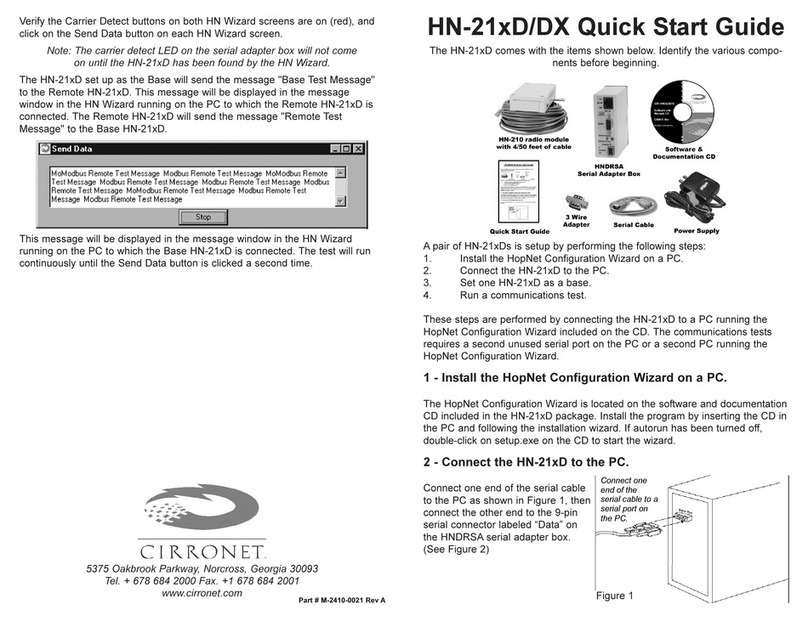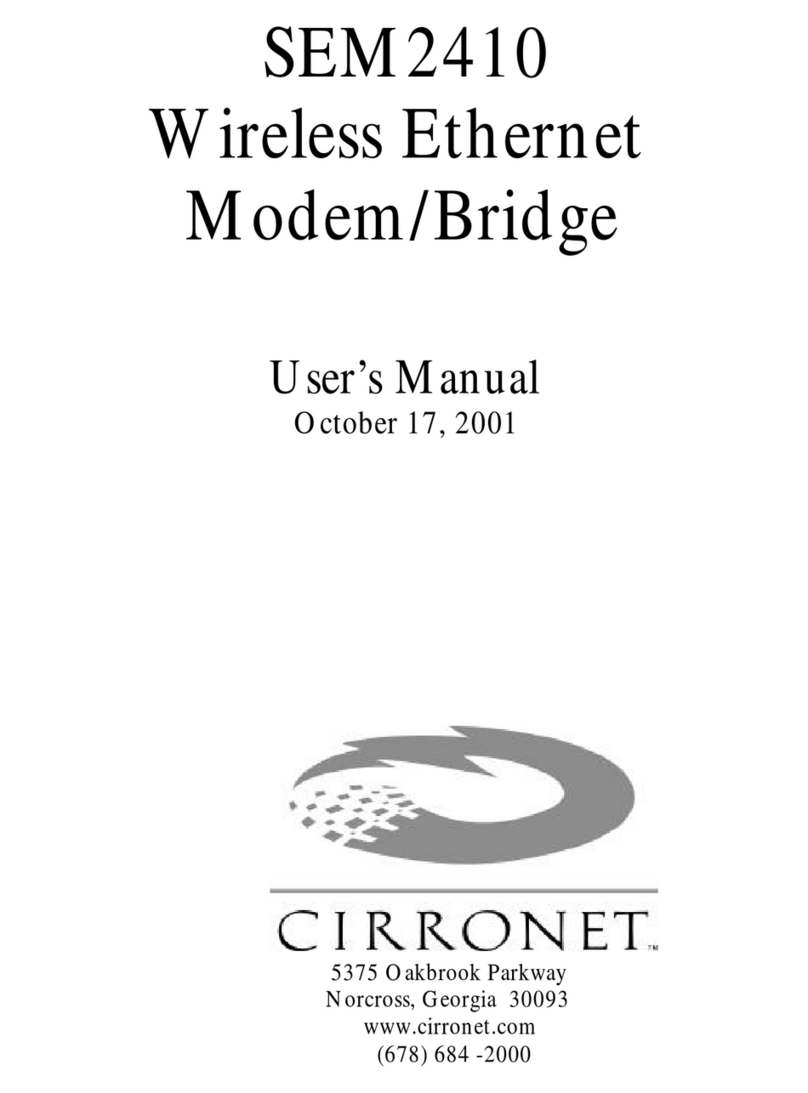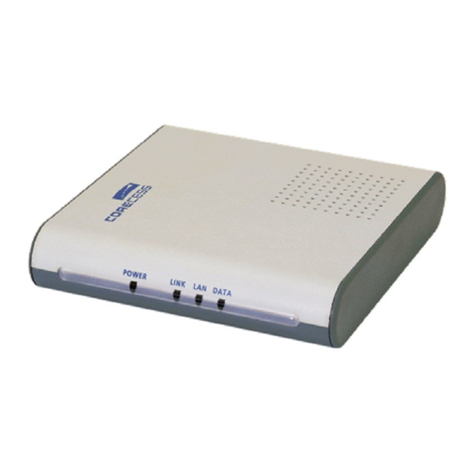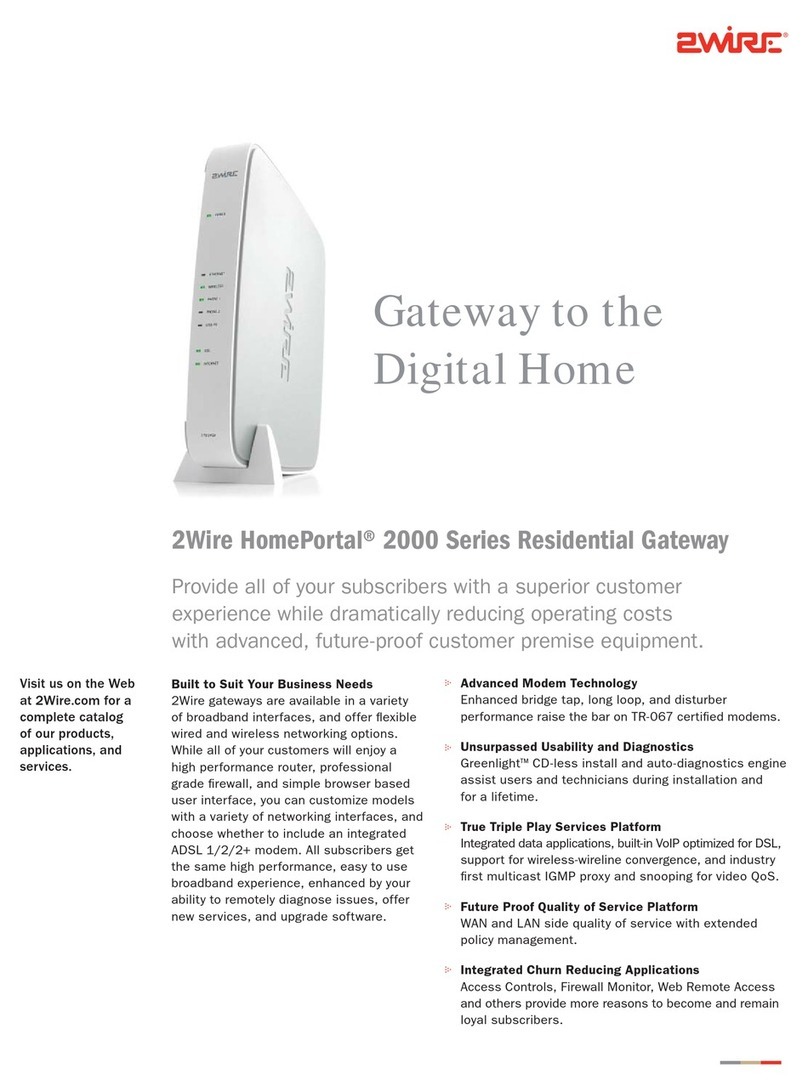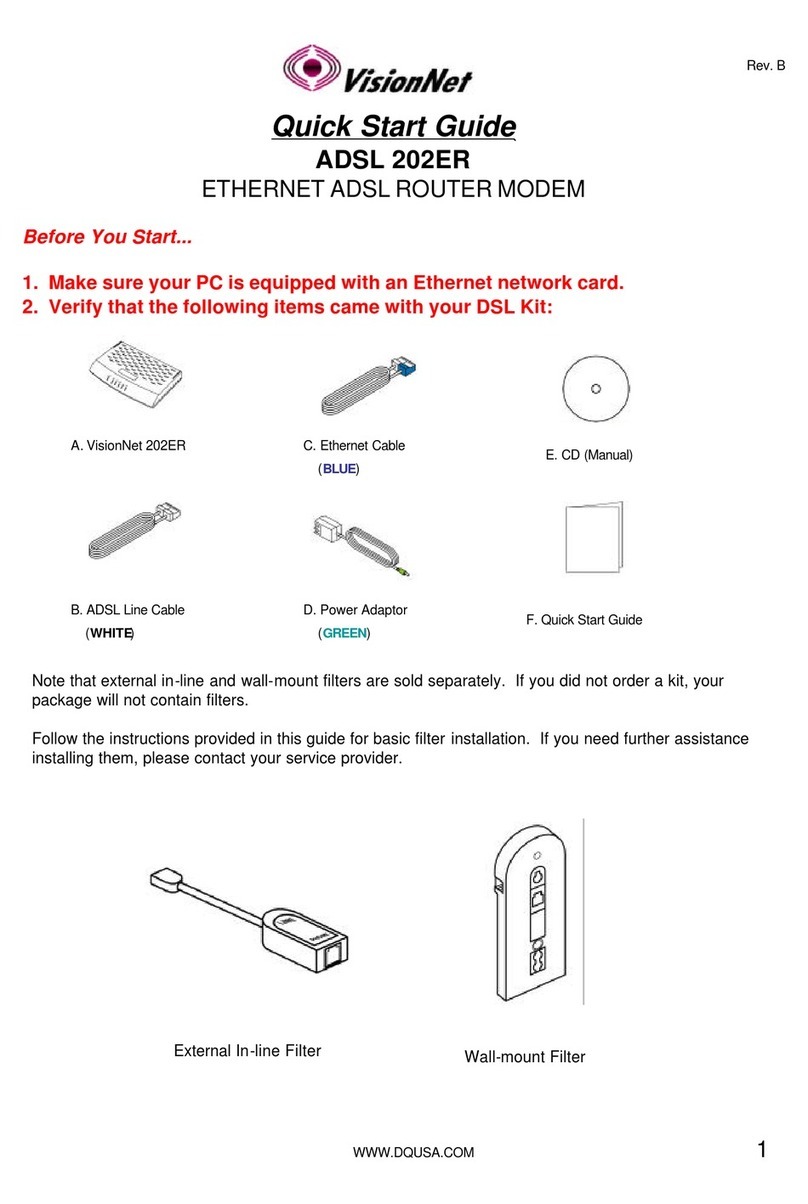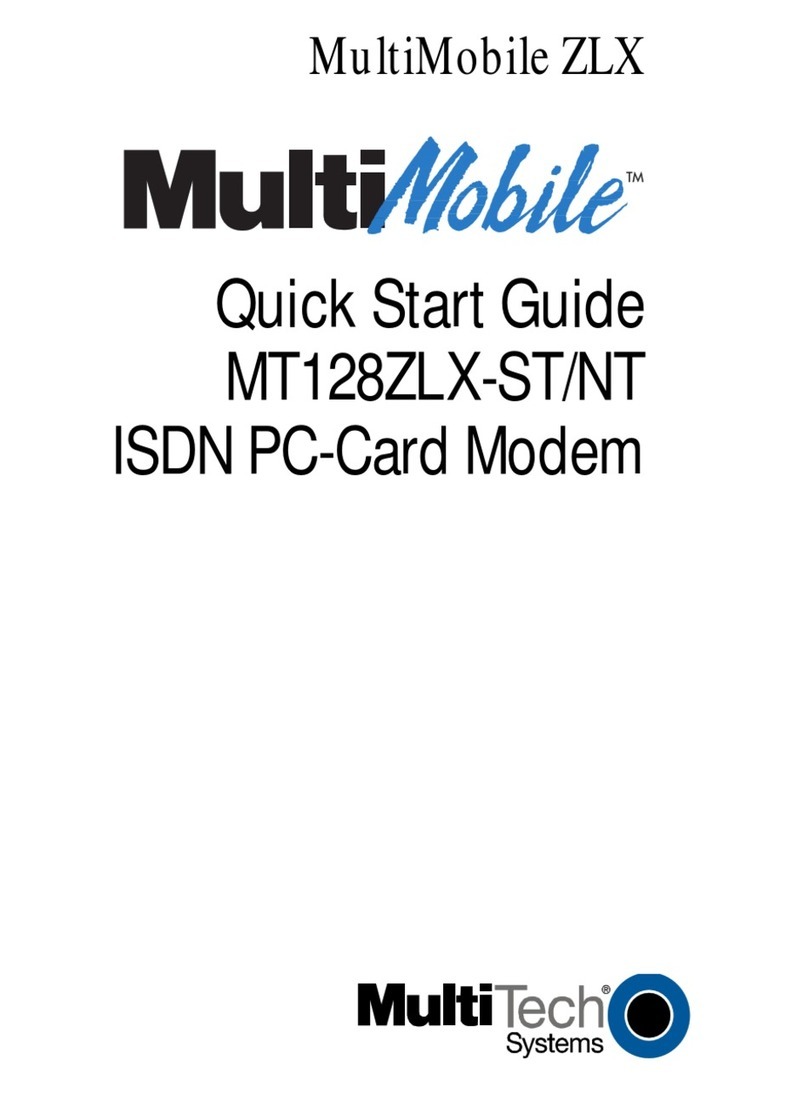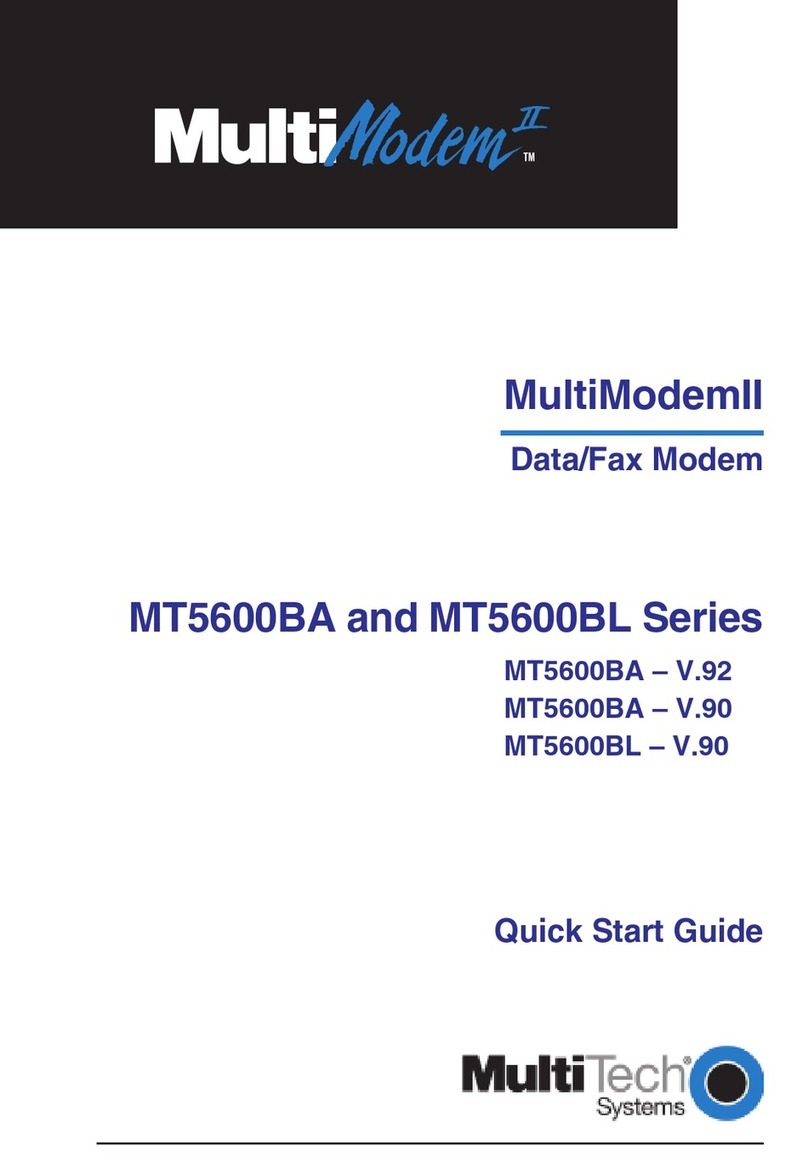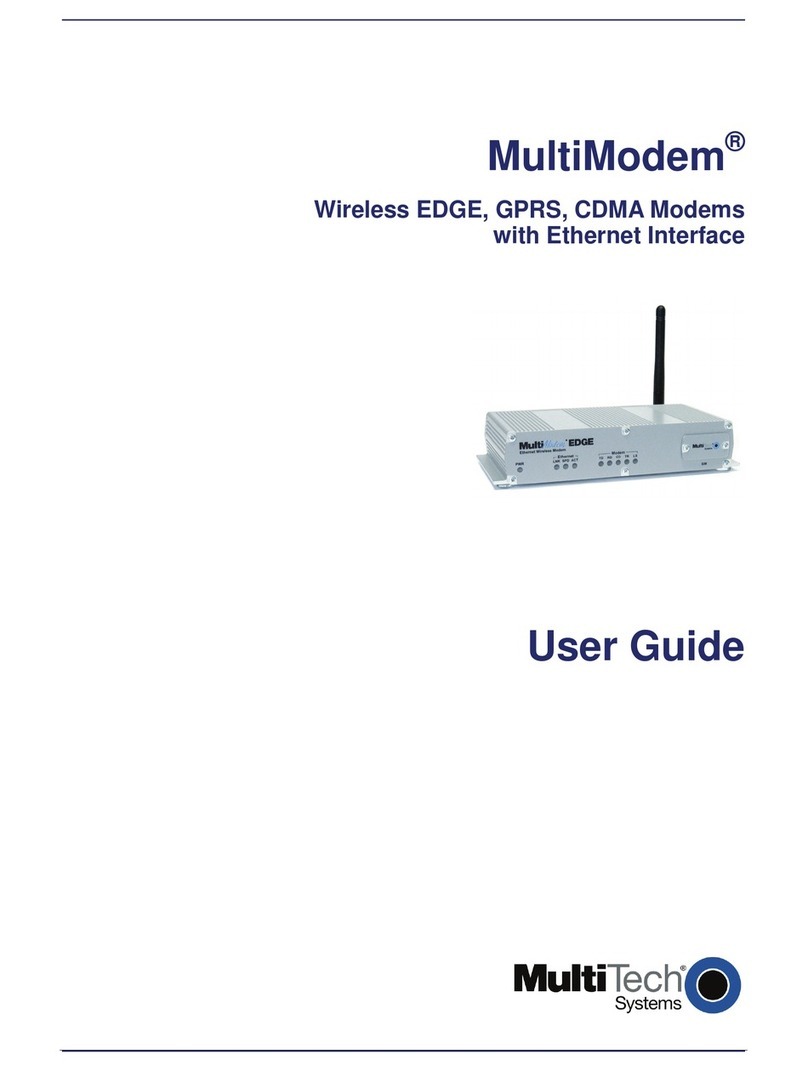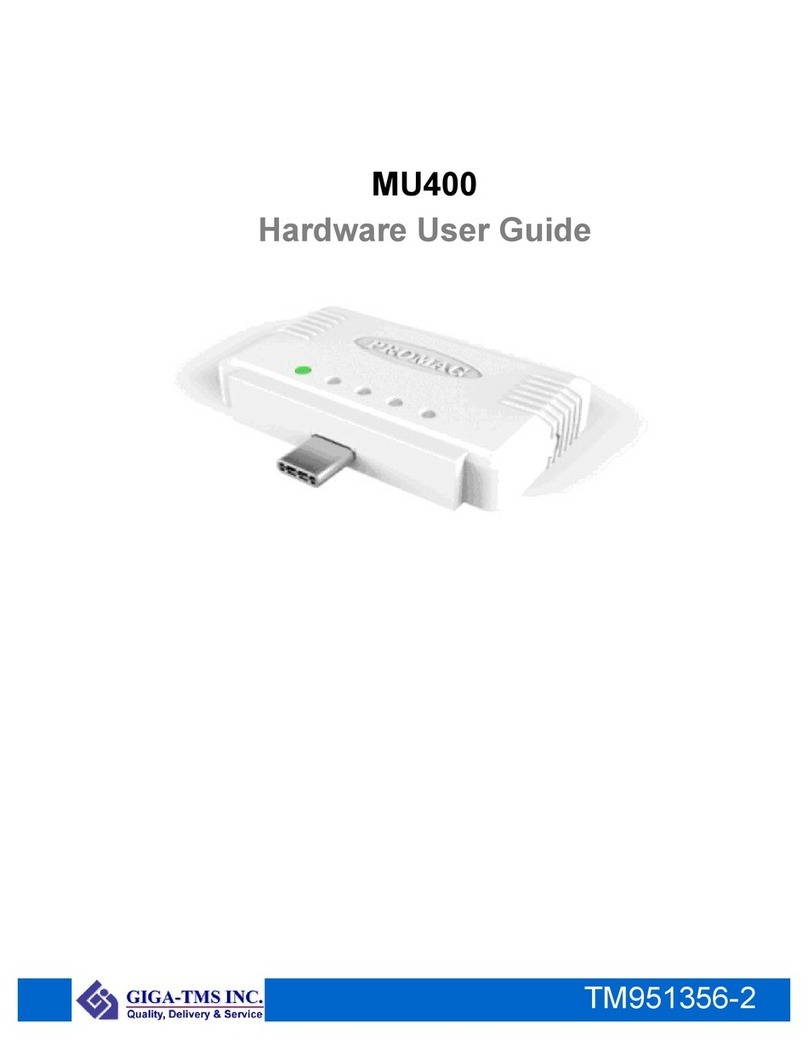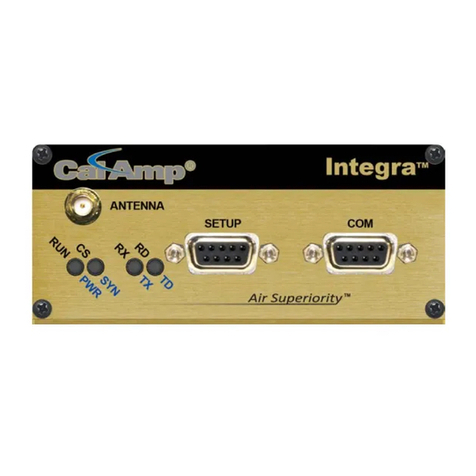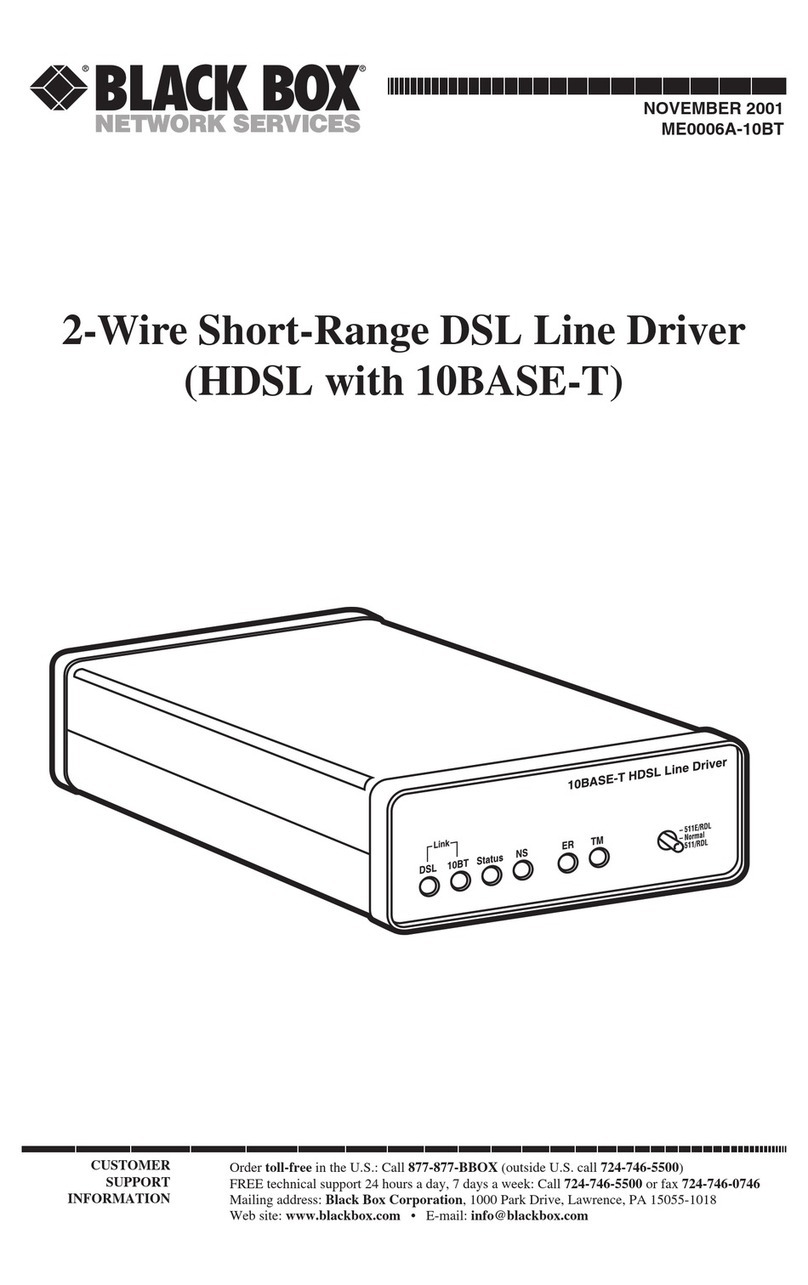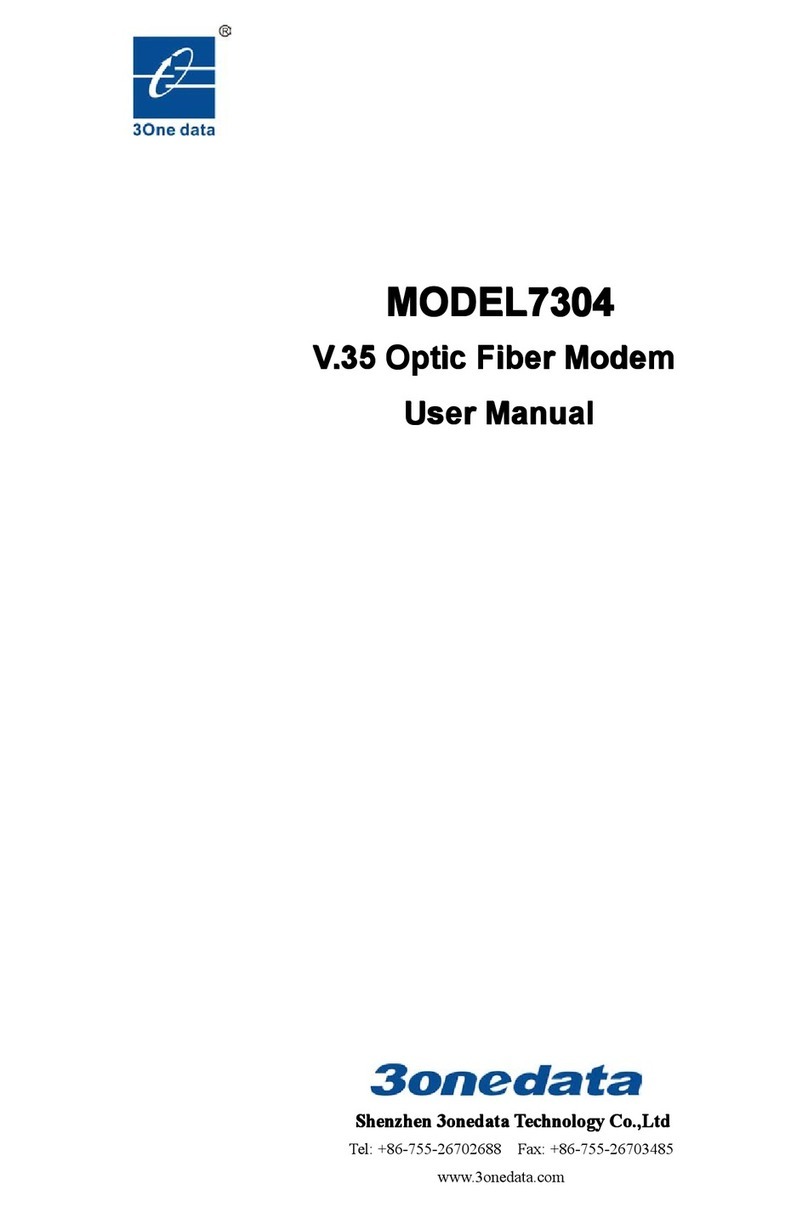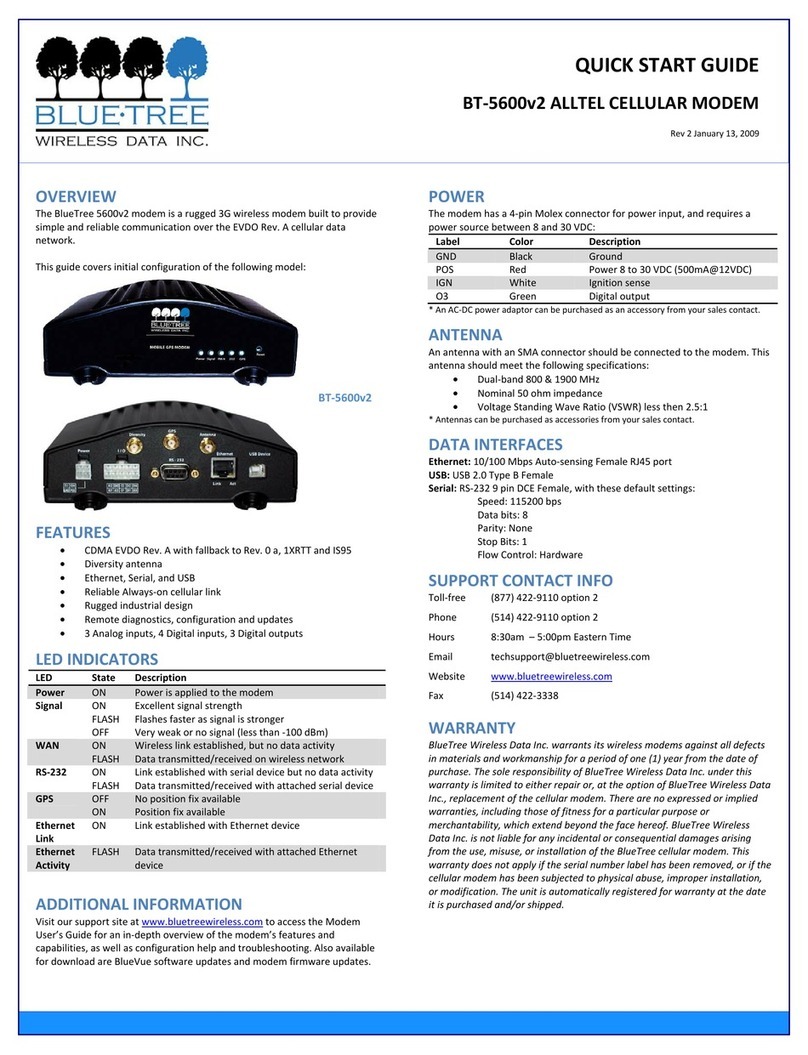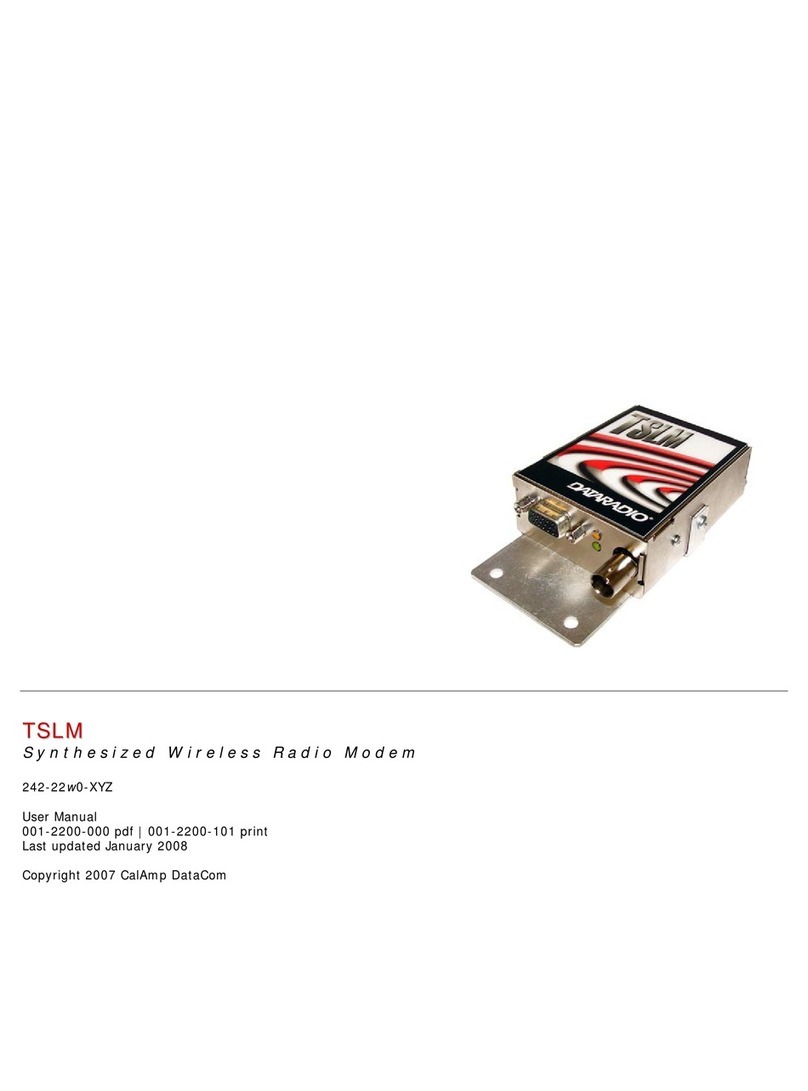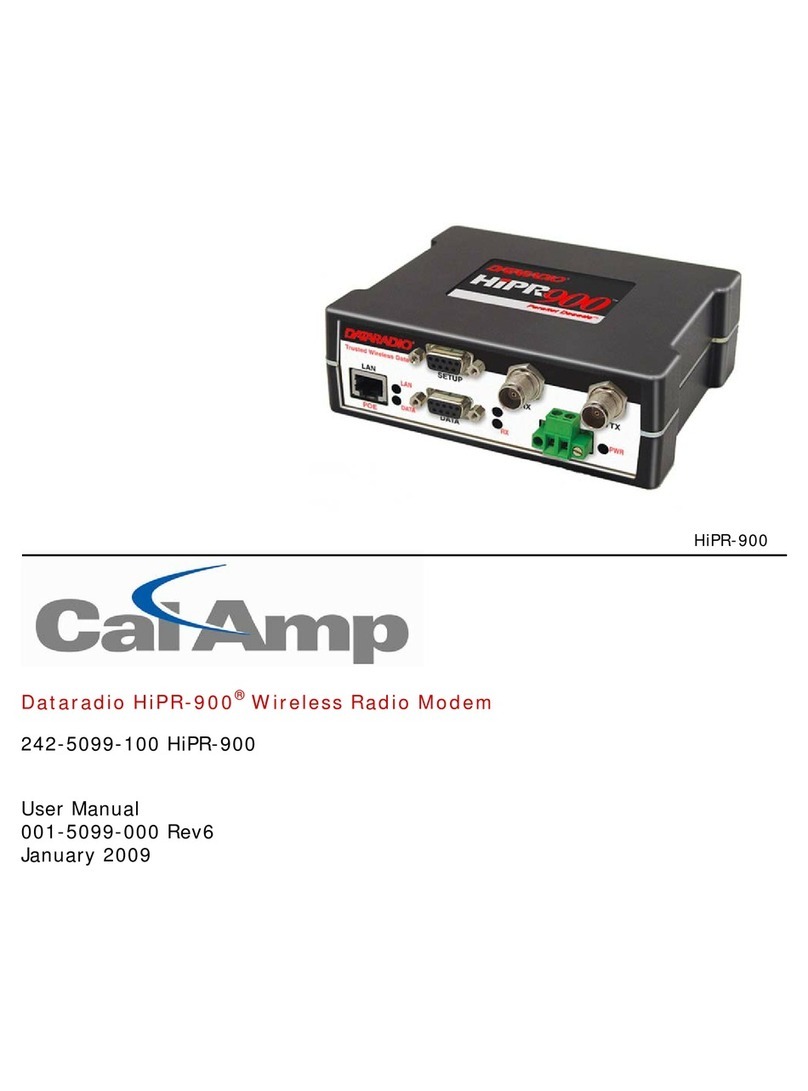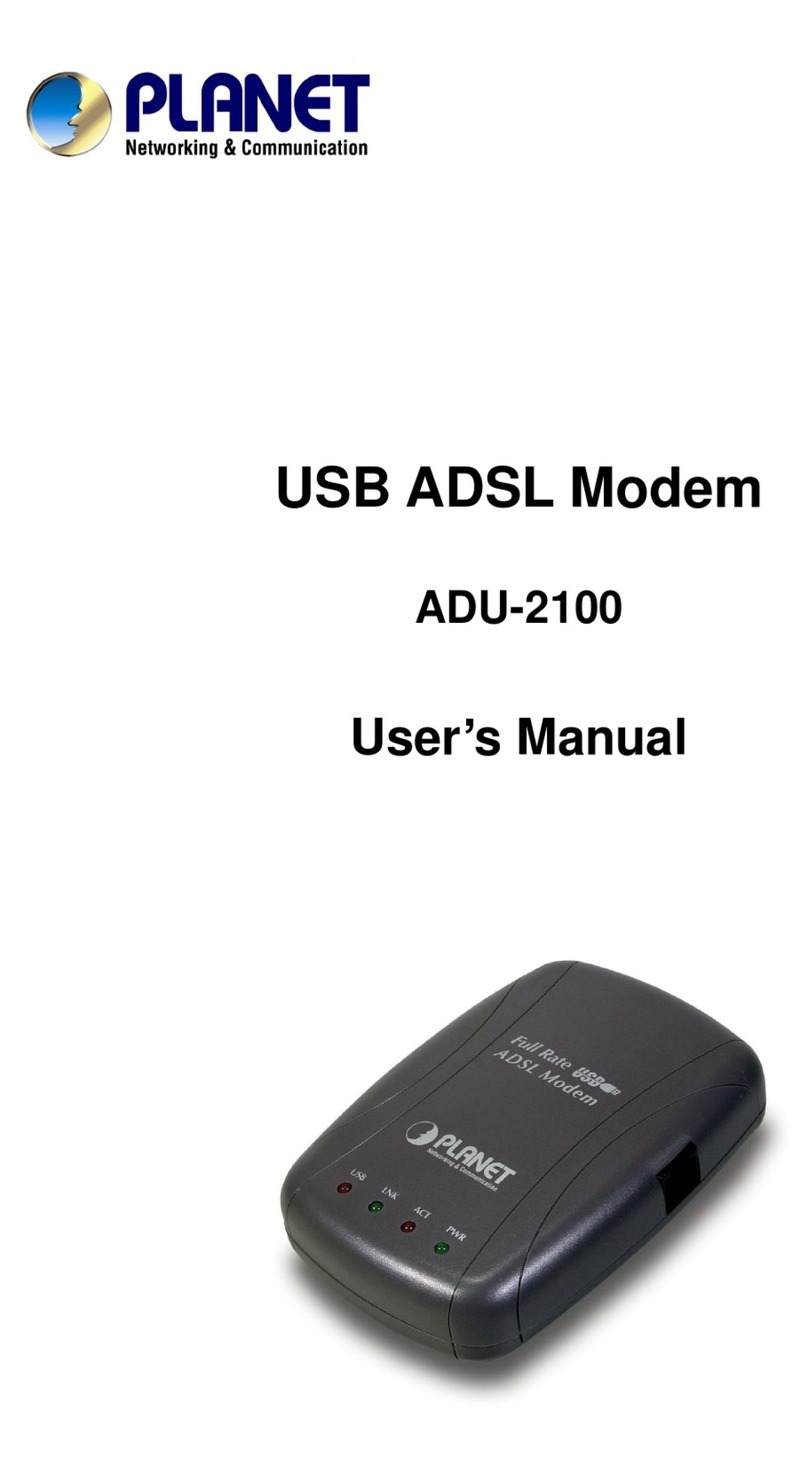Cirronet HopNet 10 Series User manual

HopNet 10 Series
Wireless Modems
User’s Manual
July 16, 2001
5375 Oakbrook Parkway
Norcross, Georgia 30093
www.cirronet.com
678-684-2000

Operational Safety Notes
ii HopNet Family of Products 800281Rev. B
Operational Safety Notes
FCC Notice, U.S.A.
All HopNet products comply with Part 15 of the FCC Rules. Operation is subject to
the following conditions:
•This device may not cause harmful interference, and this device must accept any
interference received, including interference that may cause undesired operation.
•This device is specifically designed to be used under Section 15.203 of the FCC
Rules and Regulations. Any unauthorized modifications or changes to this device
may void the user’s authority to operate.
•This device is intended to be used only when professionally installed. Failure to
comply with these instructions may also void the user’s authority to operate this
device.
European Community Notice
This device complies with ETS 300.328 of the European Community. Operation is
subject to the following conditions:
•This device may not cause interference.
•This device must accept interference, including undesired interference that may
impede the operation of this device.
RF Exposure
WARNING: End Users of these systems must be informed that RF exposure limits
may be exceeded if personnel come closer than 45 cm to the antenna aperture when
exceeding 9 dBi of gain in conjunction with the transceiver.
Repairs
Cirronet does not recommend field repairs of the radio equipment. Surface Mount
Technology (SMT) has been used in the production of the transceiver module, which
requires specialized training and equipment for proper servicing. The equipment
should be returned to the factory for any repair.

Warranty
800281 Rev. B HopNet Family of Products iii
Warranty Seller warrants solely to Buyer that the goods delivered hereunder shall be
free from defects in materials and workmanship, when given normal,
proper and intended usage, for twelve (12) months from the date of
delivery to Buyer. Seller agrees to repair or replace at its option and
without cost to Buyer all defective goods sold hereunder, provided that
Buyer has given Seller written notice of such warranty claim within such
warranty period. All goods returned to Seller for repair or replacement
must be sent freight prepaid to Seller’s plant, provided that Buyer first
obtain from Seller a Return Goods Authorization before any such return.
Seller shall have no obligation to make repairs or replacements which are
required by normal wear and tear, or which result, in whole or in part,
from catastrophe, fault or negligence of Buyer, or from improper or
unauthorized use of the goods, or use of the goods in a manner for which
they are not designed, or by causes external to the goods such as, but not
limited to, power failure. No suit or action shall be brought against Seller
more than twelve (12) months after the related cause of action has
occurred. Buyer has not relied and shall not rely on any oral
representation regarding the goods sold hereunder, and any oral
representation shall not bind Seller and shall not be a part of any warranty.
THE PROVISIONS OF THE FOREGOING WARRANTY ARE IN
LIEU OF ANY OTHER WARRANTY, WHETHER EXPRESS OR
IMPLIED, WRITTEN OR ORAL (INCLUDING ANY WARRANTY
OR MERCHANT ABILITY OR FITNESS FOR A PARTICULAR
PURPOSE). SELLER’S LIABILITY ARISING OUT OF THE
MANUFACTURE, SALE OR SUPPLYING OF THE GOODS OR
THEIR USE OR DISPOSITION, WHETHER BASED UPON
WARRANTY, CONTRACT, TORT OR OTHERWISE, SHALL
NOT EXCEED THE ACTUAL PURCHASE PRICE PAID BY
BUYER FOR THE GOODS. IN NO EVENT SHALL SELLER BE
LIABLE TO BUYER OR ANY OTHER PERSON OR ENTITY FOR
SPECIAL, INCIDENTAL OR CONSEQUENTIAL DAMAGES,
INCLUDING, BUT NOT LIMITED TO, LOSS OF PROFITS, LOSS
OF DATA OR LOSS OF USE DAMAGES ARISING OUT OF THE
MANUFACTURE, SALE OR SUPPLYING OF THE GOODS. THE
FOREGOING WARRANTY EXTENDS TO BUYER ONLY AND
SHALL NOT BE APPLICABLE TO ANY OTHER PERSON OR
ENTITY INCLUDING, WITHOUT LIMITATION, CUSTOMERS
OF BUYERS.

OPERATIONAL SAFETY NOTES.............................................................................................................................II
FCC Notice, U.S.A..........................................................................................................................................ii
European Community Notice ..........................................................................................................................ii
RF Exposure...................................................................................................................................................ii
Repairs...........................................................................................................................................................ii
Warranty.......................................................................................................................................................iii
CHAPTER 1 HOPNET FAMILY OF PRODUCTS.......................................................................................1
OVERVIEW.......................................................................................................................................................... 1
Introduction....................................................................................................................................................1
HopNet Products............................................................................................................................................1
Design Features .............................................................................................................................................2
Glossary of Terms...........................................................................................................................................2
ABOUT HOPNET PRODUCTS.................................................................................................................................4
Introduction....................................................................................................................................................4
Operating Frequency......................................................................................................................................4
HopNet Frequency Hopping Spread Spectrum Advantages.............................................................................. 4
HopNet Data Integrity.................................................................................................................................... 4
Flexible Power Management ..........................................................................................................................4
HN-210 AND HN-210X BASE/REMOTES.............................................................................................................. 5
Introduction....................................................................................................................................................5
Design Features .............................................................................................................................................5
Remote Pin-Out, RS-232.................................................................................................................................7
Aiming the Antenna and Placing the Remote................................................................................................... 8
Interconnect Cable .........................................................................................................................................8
Technical Specifications .................................................................................................................................9
HN-510 BASE/REMOTE STATION....................................................................................................................... 11
Introduction.................................................................................................................................................. 11
Data Transmission........................................................................................................................................ 11
LED Status................................................................................................................................................... 12
Power Connection........................................................................................................................................ 12
Antenna Connection ..................................................................................................................................... 12
Technical Specifications ............................................................................................................................... 13
HN-1010 OUTDOOR BASE/REMOTE STATION..................................................................................................... 15
Introduction.................................................................................................................................................. 15
Data Transmission........................................................................................................................................ 15
Power Connection........................................................................................................................................ 16
Antenna Connection ..................................................................................................................................... 16
Technical Specifications ............................................................................................................................... 17
HN-1510 OUTDOOR BASE/REMOTE STATION..................................................................................................... 19
Introduction.................................................................................................................................................. 19
Data Transmission........................................................................................................................................ 19
LED Status................................................................................................................................................... 20
Power Connection........................................................................................................................................ 20
Antenna Connection ..................................................................................................................................... 20
Technical Specifications ............................................................................................................................... 21
HN-2010 OUTDOOR BASE/REMOTE STATION..................................................................................................... 23
Introduction.................................................................................................................................................. 23
Design Features ........................................................................................................................................... 23
Antenna and Power Connections................................................................................................................... 24
Three-Way Switch......................................................................................................................................... 25
LED Status................................................................................................................................................... 25
Power........................................................................................................................................................... 26
Antenna Connectors ..................................................................................................................................... 26
Configuring the Repeater.............................................................................................................................. 27
Technical Specifications ............................................................................................................................... 28
HN-3010 OUTDOOR BASE/REMOTE STATION..................................................................................................... 30

Table of Contents
800281 Rev. B HopNet Family of Products v
Introduction.................................................................................................................................................. 30
Design Features ........................................................................................................................................... 30
Remote Pin-Out, RS-232............................................................................................................................... 31
Remote Pin-Out, RS-485............................................................................................................................... 32
Cable Interface............................................................................................................................................. 33
Aiming the Antenna and Placing the Remote................................................................................................. 33
Technical Specifications ............................................................................................................................... 34
TYPICAL HOPNET APPLICATIONS ...................................................................................................................... 36
Introduction.................................................................................................................................................. 36
Point to Multipoint ....................................................................................................................................... 36
Point-to-Point............................................................................................................................................... 37
CHAPTER 2 FUNCTIONAL DESCRIPTION................................................................................................. 39
OVERVIEW........................................................................................................................................................ 39
Introduction.................................................................................................................................................. 39
NETWORK COMMUNICATION............................................................................................................................. 40
Introduction.................................................................................................................................................. 40
Synchronizing the Base with the Remotes...................................................................................................... 40
Data Transmission........................................................................................................................................ 40
Channel Access ............................................................................................................................................ 41
Full Duplex Communication......................................................................................................................... 42
Error-free Packet Transmission Using ARQ.................................................................................................. 43
POINT-TO-POINT NETWORKS............................................................................................................................. 44
Introduction.................................................................................................................................................. 44
Throughput................................................................................................................................................... 44
MULTIPOINT NETWORKS................................................................................................................................... 45
Introduction.................................................................................................................................................. 45
Protocol Modes Definitions .......................................................................................................................... 47
Packet Formats ............................................................................................................................................ 48
Data Packet.................................................................................................................................................. 48
Connect Packet............................................................................................................................................. 49
Disconnect Packet (base only, receive only)................................................................................................. 49
Transparent Broadcast Network.................................................................................................................... 50
Typical Point-to-Multipoint Networks ........................................................................................................... 51
MINIMIZING LATENCY ...................................................................................................................................... 54
Introduction.................................................................................................................................................. 54
Data Rates.................................................................................................................................................... 54
Packet Size................................................................................................................................................... 54
Dwell Time................................................................................................................................................... 54
MINIMIZING POWER CONSUMPTION................................................................................................................... 55
Introduction.................................................................................................................................................. 55
Power Consumption ..................................................................................................................................... 55
Sleep Mode................................................................................................................................................... 55
Duty Cycling ................................................................................................................................................ 55
CHAPTER 3 CONFIGURING THE NETWORK............................................................................................ 57
OVERVIEW........................................................................................................................................................ 57
Introduction.................................................................................................................................................. 57
Five Command Types ................................................................................................................................... 57
INSTALLING THE WINCOM24 SOFTWARE........................................................................................................... 58
MODEM COMMANDS......................................................................................................................................... 59
SERIAL COMMANDS .......................................................................................................................................... 60
Set Data Rate Divisor................................................................................................................................... 60
Set Protocol Mode........................................................................................................................................ 61
NETWORK COMMANDS...................................................................................................................................... 62
Set Transceiver Mode................................................................................................................................... 62

Set Default Handle ....................................................................................................................................... 62
Enable Global Network Mode....................................................................................................................... 63
Set Hopping Pattern ..................................................................................................................................... 63
Set Transmit Power....................................................................................................................................... 63
Read Receive Signal Strength Indicator (RSSI).............................................................................................. 63
Set Range Optimization ................................................................................................................................ 64
PROTOCOL COMMANDS..................................................................................................................................... 65
Set Alternative Frequency Band.................................................................................................................... 66
Set Hop Duration.......................................................................................................................................... 66
Set Minimum Data Length ............................................................................................................................ 66
Get Maximum Data Length (read only)......................................................................................................... 66
Set Maximum Number of Remotes (base only)............................................................................................... 67
Set Packet Attempts Limit ............................................................................................................................. 67
Set Data Transmit Delay............................................................................................................................... 67
Set Slot Assignment Mode (base station only)................................................................................................ 67
Set Base Slot Size (base station only)............................................................................................................. 68
Set ARQ Mode.............................................................................................................................................. 68
STATUS COMMANDS ......................................................................................................................................... 69
Banner Display Disable................................................................................................................................ 69
Set Escape Sequence Mode........................................................................................................................... 69
Read Factory Serial Number High, Middle and Low Bytes. ........................................................................... 70
Set Duty Cycle.............................................................................................................................................. 70
Enable Low Power Acquisition Mode............................................................................................................ 70
MEMORY COMMANDS....................................................................................................................................... 71
Recall Factory Defaults................................................................................................................................ 71
Recall Memory............................................................................................................................................. 71
Store Memory............................................................................................................................................... 71
MODEM COMMAND SUMMARY.......................................................................................................................... 72
GUIDELINES FOR INSTALLATION........................................................................................................................ 73
GUIDELINES FOR PLACING THE REPEATER.......................................................................................................... 73
CHAPTER 4 TROUBLESHOOTING...............................................................................................................75
OVERVIEW........................................................................................................................................................ 75
Introduction.................................................................................................................................................. 75
Transceiver Requirements............................................................................................................................. 75
COMMON SYSTEM PROBLEMS............................................................................................................................ 76
GUIDELINES FOR REDUCING INTERFERENCE....................................................................................................... 77
Introduction.................................................................................................................................................. 77
Guidelines for Setting Up the Network .......................................................................................................... 77
Guidelines for Selecting Your Site................................................................................................................. 77
GUIDELINES FOR AVOIDING TERRAIN OBSTRUCTIONS ........................................................................................ 78
CUSTOMER SUPPORT......................................................................................................................................... 79
Introduction.................................................................................................................................................. 79
Technical Assistance..................................................................................................................................... 79
Factory Repairs............................................................................................................................................ 79
APPENDIX A MECHANICAL DRAWINGS.....................................................................................................1
OVERVIEW.......................................................................................................................................................... 1
Introduction....................................................................................................................................................1
HN-1510............................................................................................................................................................ 2
HN-2010............................................................................................................................................................ 3
HN-3500............................................................................................................................................................ 4
HN-3010............................................................................................................................................................ 5
HN-1010............................................................................................................................................................ 6
APPENDIX B HN-1010 AND HN-3010 INTERFACE SETUP...........................................................................1
OVERVIEW.......................................................................................................................................................... 1

Table of Contents
800281 Rev. B HopNet Family of Products vii
Introduction....................................................................................................................................................1
HN-1010 ........................................................................................................................................................1
HN-3010 ........................................................................................................................................................1
JUMPER CONFIGURATION OF HN-3010.................................................................................................................2
APPENDIX C ACCESSORIES...........................................................................................................................1
OVERVIEW.......................................................................................................................................................... 1
Introduction....................................................................................................................................................1
ANTENNAS .........................................................................................................................................................2
Types of Antennas...........................................................................................................................................2
Guidelines......................................................................................................................................................2
ADAPTER............................................................................................................................................................ 3
Introduction....................................................................................................................................................3
Flow Control Indicators .................................................................................................................................4
DB-9 Connector ............................................................................................................................................. 4
Terminal Block............................................................................................................................................... 5
POWER SUPPLY...................................................................................................................................................6
Introduction....................................................................................................................................................6
AC to DC Conversion.....................................................................................................................................6
Alternate Power Sources................................................................................................................................. 6

This page intentionally left blank.

OVERVIEW
800281 Rev. B HopNet Family of Products
1
Chapter 1
HopNet Family of Products
Overview
Introduction
The HopNet 10 Series family of products provides reliable wireless connectivity for
either point-to-point or point-to-multipoint applications. The HopNet products are
built around the WIT2410 radio transceiver, which employs frequency hopping
spread spectrum technology. This technology ensures:
•Maximum resistance to noise
•Maximum resistance to multipath fading
•Robustness in the presence of interfering signals
HopNet Products
The HopNet family of products is built with rugged enclosures compliant with IP 66
and NEMA 4X standards for outdoor and harsh industrial environments. All
Hopnet products work with each other and can be mixed and matched in a single
network. All HopNet Products are WIT2410 compatible and can be used with the
WIT2410 OEM based products as well as with the SNAP2410 10Base T access point.
The HopNet family consists of the following products:
External Antenna
HN-210X Base/Remote Unit
HN-510 Indoor Base/Remote Station
HN-1010 Outdoor Base/Remote Station
HN-1510 Indoor Base/Remote Station
HN-2010 Repeater
Built-In Antenna
HN-210 Base/Remote Unit
HN-3010 Base/Remote Unit
Accessories
Antennas
Adapter
Power Supplies

OVERVIEW
HopNet Family of Products 800281Rev. B
2
Design Features
The HopNet modems have many advanced features:
•Employ frequency hopping technology with up to 75 channels in the 2401 to 2475
MHz frequency range
•Support RS-232 and RS 485 interfaces (HN-210 and HN-510 are RS-232 only)
•Support digital addressing for up to 64 networks, with 62 remotes per network.
•Use transparent ARQ protocol
•Use same hardware for all supported data rates
•Supports up to 230 Kbps asynchronous data rates
•Full Duplex
•Stores setup configuration in nonvolatile memory (FLASH)
•Provide fast acquisition – less than 2 seconds is the typical time to acquire hopping
pattern
•Use smart power management features
Glossary of Terms
Refer to the following list of terms that may be unfamiliar to you. These terms are
used throughout this document.
Term Definition
ARQ Automatic Repeat Request. The operation in which the radio
will re-send the data until it is received correctly.
bps Bits-per-second. A measure of information transfer rate of
digital data across a channel.
Decibel A measure of the ratio between two signal levels. Used to
express either loss or gain.
dBi Decibels referenced to an ideal isotropic radiator in free space.
Used to express antenna gain.
dBm Decibels referenced to 1 milliwatt. An absolute unit used to
measure signal power. Transmitter power output or received
signal strength.
DCE Data Communications Equipment. A device that receives data
in the form of digital signals at its input. The modem side of a
computer-to-modem connection.
DCD Data Carrier Detect.

OVERVIEW
800281 Rev. B HopNet Family of Products
3
Term Definition
DTE Data Terminal Equipment. A device that provides data in the
form of digital signals at its output. The computer side of a
computer-to-modem connection.
EIRP Effective Isotropic Radiated Power.
ISM Industrial, Scientific, or Medical band operating at 2.4 GHz.
Allows use of a radio without a license, but the equipment
must be immune to interference from other users in the band
and approved for use in the intended country.
Latency The delay between when data is received on TX until it is
output on RX.
RMA Return Material Authorization.
RTU Remote Terminal Unit. A device used in data collection.
TDMA Time Division Multi Access. A time slot multiplexing protocol
for multinode networking.

ABOUT HOPNET PRODUCTS
HopNet Family of Products 800281Rev. B
4
About Hopnet Products
Introduction
This section provides operational information about the HopNet products.
Operating Frequency
The HopNet family operates in the 2.4 GHz ISM band that allows for license-free use
and worldwide compliance.
HopNet Frequency Hopping Spread Spectrum Advantages
In the frequency domain, a multipath fade can be described as a frequency selective
notch that shifts in location and depth over time. Multipath fades typically occupy
five percent of the band. A conventional radio system typically has a five percent
chance of signal impairment at any given time due to multipath fading.
Frequency Hopping Spread Spectrum reduces the vulnerability of a radio system to
both interference from jammers and multipath fading by distributing or spreading
the signal over a larger region of the frequency band.
The fade resistant, HopNet frequency-hopping technology employs up to 75
channels and switches channels over 100 times a second to achieve high reliability
throughput.
HopNet Data Integrity
An on-board 3 KB buffer and error correcting over-the-air protocol ensure data
integrity even in the presence of weak signals or jammers. The serial interface
handles both data and control of asynchronous data rates of up to 230 Kbps.
Flexible Power Management
You can set the transmit power at 10 milliwatts or 100 milliwatts. Reduced power
can reduce the size of the coverage zone, which may be desirable for multiple
network indoor applications. You can also place the transceiver module in a power-
save mode, which enables smart power management. Smart power management
allows a remote unit to drop into a lower current standby mode during transmission
or receiving gaps.
This feature also allows Hopnet products to be used in various countries where the
output power requirements may vary due to regulation.

HN-210 AND HN-210X BASE/REMOTES
800281 Rev. B HopNet Family of Products
5
HN-210 and HN-210X Base/Remotes
Introduction
The HN-210 and HN-210X are NEMA 4X weatherproof versions of the HopNet
product line. The interface to the 210 and 210X allows the Host to communicate with
the Remote unit through an integrated 50 ft (15 meter) cable.
Design Features
The HN-210 Remote has an internally mounted 6 dBi patch antenna. The built-in
antenna of the HN-210 case greatly eases outdoor installation since no antenna
feedline cable or adapters are needed. The 6 dBi antenna gain increases the radiated
EIRP to +24 dBm and the effective receiver sensitivity to –99 dBm. The HN-210X has
a TNC connector for attaching an external antenna and a mounting plate that
accommodates both the HN-210X and any of the following external antennas:
Corner249
Corner2414
Omni249
Omni2412
The HN-210 and HN-210X remotes interface with the user’s hardware through an
interface adapter. The interface adpater supplies power and signal to the remote
unit. The interface to the remote unit is a standard RS-232 DB-9 serial interface.
Eight is the minimum number of pins necessary to convey all of the signals needed
to communicate with the modem inside the remote unit. The interface adapter also
supplies power to the remote unit thorough an AC to DC power adapter. See the
illustrations below.
Interface Box

HN-210 AND HN-210X BASE/REMOTES
HopNet Family of Products 800281Rev. B
6
The interface adapter has two LEDs. The green LED indicates that the unit is
receiving power. The amber LED indicates Data Carrier Detect.
Interface Box
Interface Adapter
Power Adapter
Modem Interface
LEDs
RS-232 Interface
9 Not Used
8 Clear to Send (CTS)
7 Request to Send (RTS)
6 Data Set Ready (DSR)
5 Ground
4 Data Terminal Ready (DTR)
3 Transmit Data (TX)
2 Receive Data (RX)
1 Data Carrier Detect (DCD)

HN-210 AND HN-210X BASE/REMOTES
800281 Rev. B HopNet Family of Products
7
Remote Pin-Out, RS-232
Pin Number Signal Type Description
1DCD Output •Data Carrier Detect. For remotes, DCD
indicates that the remote has successfully
acquired the hopping pattern.
2RXD Output •Output for received serial data.
3TXD Input •Input Serial Data to be transmitted
4DTR Input •Data Terminal Ready. Sleep/ wakes radio
transceiver.
5GND -•Signal and Chassis Ground
6DSR Output •Data Set Ready. Response to DTR.
7RTS Input •Request to Send. Gates the flow of receive
data from the radio to the user on or off. In
normal operation signal should be asserted.
8CTS Output •Clear to Send. Used to control transmit flow
from the user to the user to the radio. The
WIT 2410 radio module supports hardware
flow control only and does not support
software flow control (e.g. Xon-Xoff).
9Not Used -•Not Used
Note: When the HN-210 and HN-210X are used as three wire serial devices, DTR and
RTS do not have to be used.

HN-210 AND HN-210X BASE/REMOTES
HopNet Family of Products 800281Rev. B
8
Aiming the Antenna and Placing the Remote
Use the following guidelines for aiming the antenna and placing the Remote.
•Do not place anything immediately in front of the antenna that could obstruct its
radiation pattern. Because the antenna in the HopNet Remote is inside the unit,
the antenna must have a clear line of sight.
•Use the sticker on the HN-210 Remote unit to help you locate and aim the antenna.
The sticker indicates which direction the antenna is pointing.
•Be sure the antenna end of the HN-210 Remote faces the Base or Repeater that it is
communicating with. Our tests have found that antenna placement is not critical
as long as the patch antenna is facing in the general direction of the other end of
the link.
•If possible, place the Remote unit at a higher elevation than the structures
surrounding it to increase range and link reliability. Since the Remote will operate
with up to 45 meters of interconnect cable between it and the Host, you can mount
the unit on top of a building or other structure that will provide higher elevation.
Interconnect Cable
The HN-210 and HN-210X come with 50’ (15 meters) of high quality interconnect
cable. Longer cable lengths are available upon request.

HN-210 AND HN-210X BASE/REMOTES
800281 Rev. B HopNet Family of Products
9
Technical Specifications
Refer to the tables below for the technical specifications for the HN-210 Remotes.
Electrical
Specification Value
Transmitter FCC ID •HSW-2410M
Transmit Power •EIRP: +24 dBm Nominal (HN-210)
•+26 dBm Maximum
Hopping Patterns •User configurable, 64 patterns (networks)
available
Number of Channels •75 US; 25 France, Spain, Japan & Canada
Line-of-Sight Range •Greater than 3.5 miles
Frequency Band •2401-2475 MHz (USA)
•2448-2478 MHz (France)
•2448-2473 MHz (Spain)
•2473-2495 MHz (Japan)
•2452-2478 MHz ( Canada)
Approvals •US FCC: Part 15. 203
•Industry Canada
•European Community: ETS 300.328 Compliance
Receiver Sensitivity •-93 dBm (HN-210 Integrated patch antenna adds 6
dB to the link budget and -99dBm sensitivity)
Data Interface •RS-232
Input Power at Connector •9 - 15 VDC Operating
•160 mA Typical (750 mA surge)

HN-210 AND HN-210X BASE/REMOTES
HopNet Family of Products 800281Rev. B
10
Mechanical
Specification Value
Case •NEMA 4X, IP 66
Size •5.1 in. x 3.1 in. x 1.4 in.
•130mm x 80mm x 35mm
Weight •1.75 lb (including cable)
•794 g
Data Connector •DB-9 Female
Interconnect Cable
Connector •RJ-45
Environmental
Specification Value
Temperature Range •-30 to +70 degrees C
Humidity •95% at +40 degrees C, Non-condensing

HN-510 Base/Remote Station
800281 Rev. B HopNet Family of Products
11
HN-510 Base/Remote Station
Introduction
The HN-510 Indoor Base/Remote Station features a compact enclosure for indoor
desktop use. The HN-510 features a rechargeable battery, and is ideally suited for
evaluation, developmental and field survey applications.
Data Transmission
The HN-510 can be used as either a base or as a remote. The HN-510 can usually
transmit over a range of 300 to 1000 feet indoors. You can extend this range by
adding a HopNet Repeater (HN-2010).
The automatic repeat requests (ARQ) and multinode protocol are transparent to the
user equipment. User data rates of 230 Kbps are supported with built-in CRC/ARQ
error protocols. Data signals are EIA RS-232 standard for Data Communications
Equipment (DCE) devices.
Data and control of the radio are passed through a standard DB9 connector. See the
following illustration for the signal description.
9 Not Used
8 Clear to Send (CTS)
7 Request to Send (RTS)
6 Data Set Ready (DTR)
5 Ground
4 Not Used
3 Transmit Data (TX)
2 Receive Data (RX)
1 Data Carrier Detect (DCD)

HN-510 Base/Remote Station
HopNet Family of Products 800281Rev. B
12
LED Status
The four LED indicators are included on the front panel to provide the status of the
HN-510 Indoor Base/Remote station. See the illustration below. These built-in flow
control indicators allow you to quickly check the operational status.
The table below describes the function of each LED.
Name Color Description
PWR Green Continuous DC power is applied
TX Red RS-232 signal input
RX Red RS-232 signal output
CD Red Normal operation is asserted
Power Connection
The HN-510 is supplied with a 110VAC wall mount power supply. However, you
can operate the HN-510 from any well-filtered 5 VDC power source. The power
supply should be capable of providing 500 milliamperes of current.
The HN-510 also has a built in battery pack that allows use of the modem without
being tethered to a power source. The battery pack charges any time the unit is
plugged in. An amber colored LED on the rear of the unit next to the power
connector indicates that the internal battery pack is charging.
Antenna Connection
The RF signal is brought in on a reverse male SMA jack connector located on the
back panel. The HN-510 comes with a 2 dB omni-directional antenna.
Use the following guidelines when installing the antenna:
•Strictly follow the antenna manufacturer’s installation instructions for proper
operation of the antenna.
•Be sure to use proper polarization for any system using a gain type antenna. If you
orient the antenna with the wrong polarization, a signal reduction of greater than
20 dB could result.
•Use proper care when installing the antenna to prevent damage.
•Be sure to securely fasten the antenna.
8
This manual suits for next models
6
Table of contents
Other Cirronet Modem manuals
